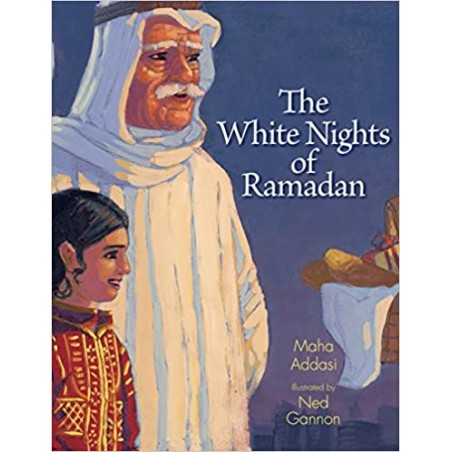



Mid-Ramadan is a special time for families in the Arabian (Persian) Gulf. These middle days are known as "the three whites," because they include the day of the full moon, the day before, and the day after. It's a time when children dress in traditional clothing and go from house to house collecting treats from their neighbors. When Noor sees the full moon rising, signaling the coming of Girgian, she and her brothers prepare for the fun. Together, they decorate the bags they'll carry to collect the candies. But along with the fun, Noor remembers the true meaning of Ramadan: spending time with family and sharing with those less fortunate.
Linked Categories
Our Review
![]()
The story is about a little girl named Noor, who is getting ready for the Girgian festival – which happens in the middle of Ramadan when the moon is full. In the story we first see Noor helping make special hard candy treats with honey, sugar and nuts. Then the kids decorate their bags with different ribbons. Next, the kids wear special clothes (this is my favorite illustration! Noor’s dress is so pretty!) Then the kids go around the neighbourhood collecting treats from neighbours. At the end of the story, Noor goes with her grandfather to share a food basket with others at the masjid.
This is a unique book about the middle eastern cultural festival known as Girgian/Gargaoun/garangaou that takes place during Ramadan (it is NOT an Islamic festival). It was completely new for me! It’s celebrated in Kuwait and other gulf countries (I’ve read that its celebrated in Saudi Arabia as well but I have not seen anyone celebrate it)
The story is about a little girl named Noor, who is getting ready for the Girgian festival – which happens in the middle of Ramadan when the moon is full. In the story we first see Noor helping make special hard candy treats with honey, sugar and nuts. Then the kids decorate their bags with different ribbons. Next, the kids wear special clothes (this is my favorite illustration! Noor’s dress is so pretty!) Then the kids go around the neighbourhood collecting treats from neighbours. At the end of the story, Noor goes with her grandfather to share a food basket with others at the masjid.
While I couldn’t find more information on the origin of the tradition, I found that it’s a festival to celebrate the kids’ efforts as they have fasted half way through Ramadan. Initially it used to be simple, but these days it’s a more elaborate event!